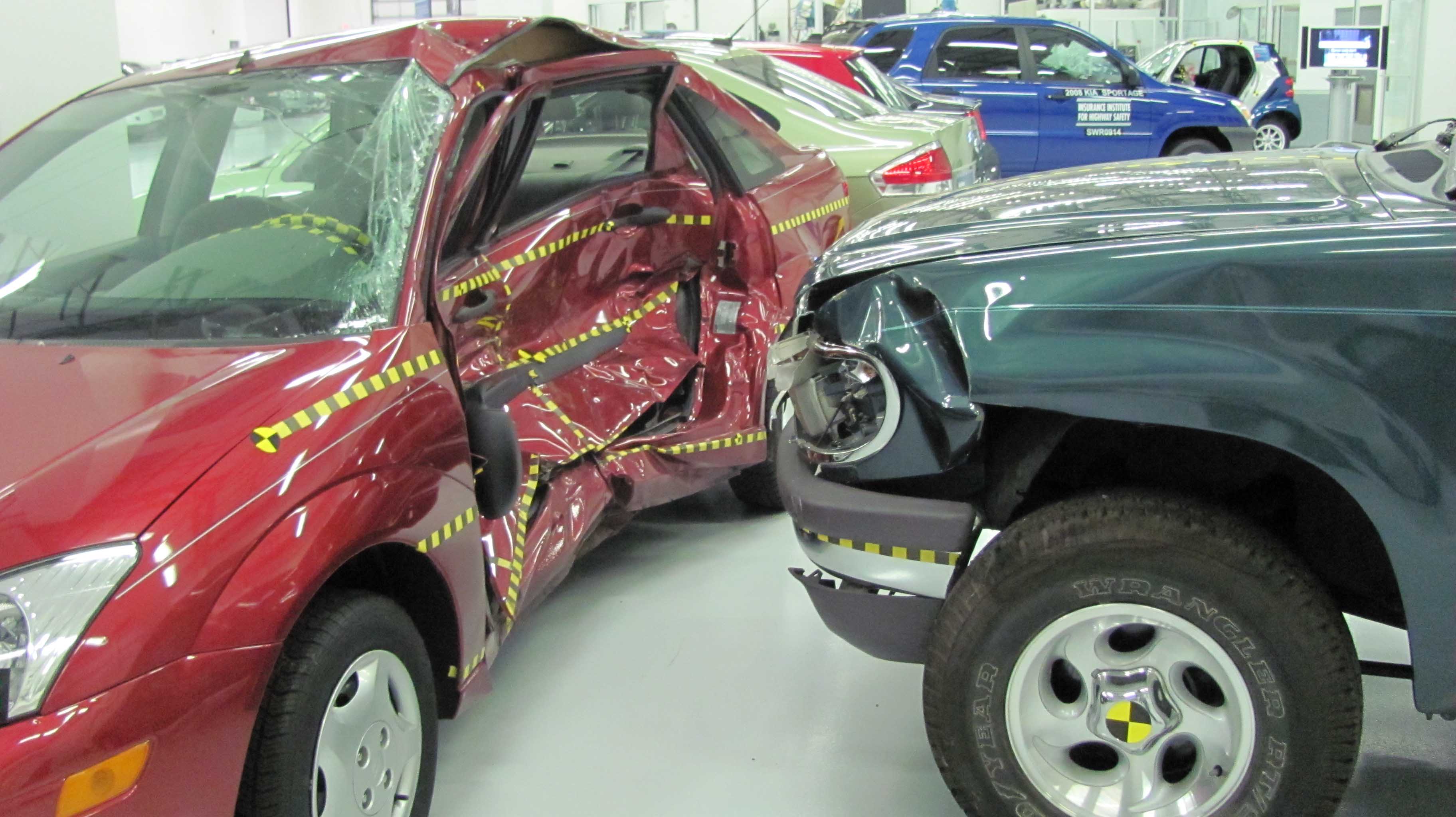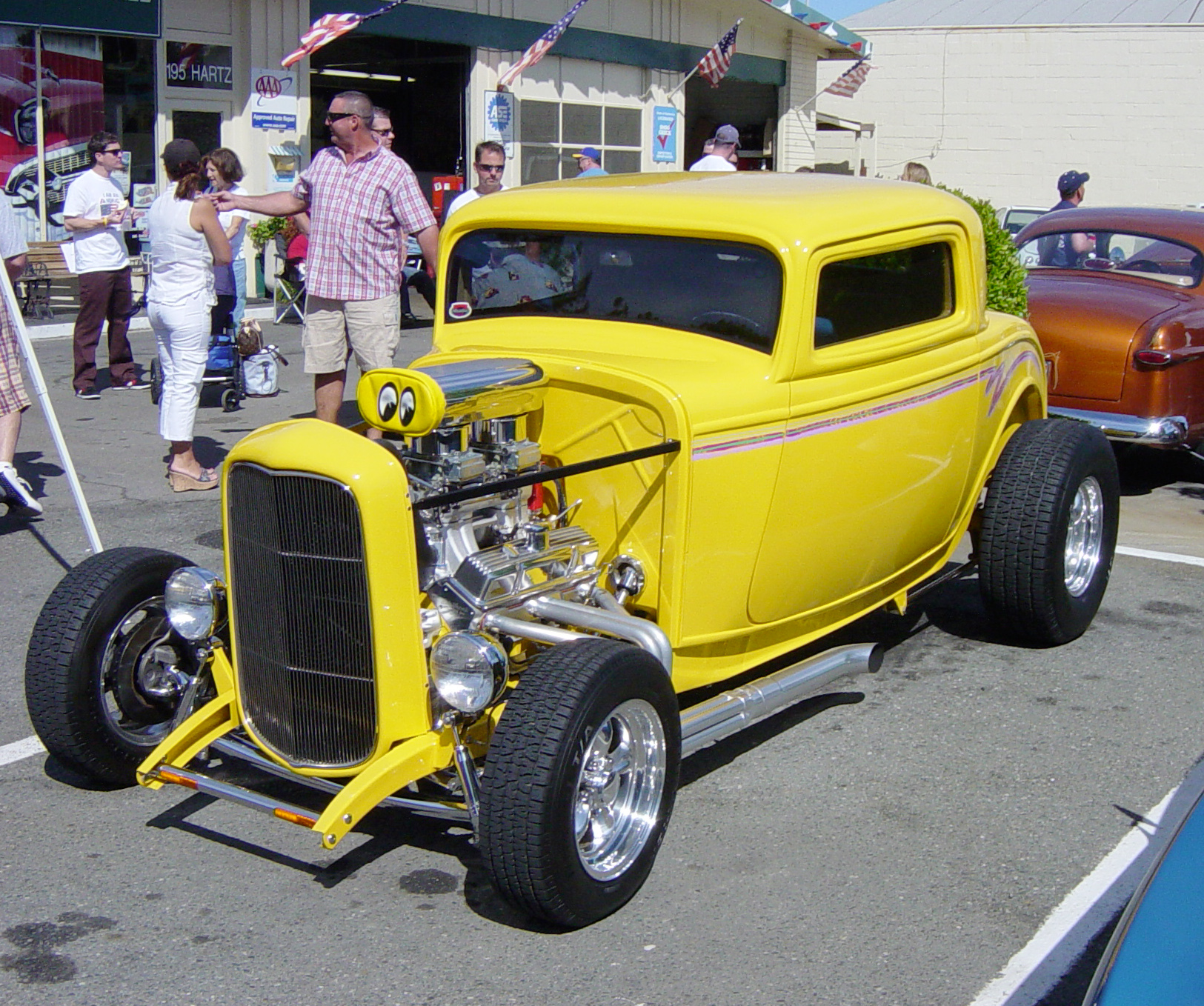|
Nerf Bar
A nerf bar is a tubular device fitted to the side of a racecar, typically single-seat race cars that compete on asphalt or dirt oval tracks. A "nerf" is a small, sometimes intentional, collision between two cars in which one driver bumps the other to facilitate a successful pass. The nerf bar protects the sides of the vehicles and also keeps their tires from becoming entangled. If fast-spinning tires come in contact with each other, one or both of the cars may lose control or even become airborne. These are commonly used on Modifieds such as used in the NASCAR Whelen Modified Series, and the wheel pods behind the rear wheels on a Dallara DW12 INDYCAR is often nicknamed the nerf bar because of the similar purpose. A more commercial application of the nerf bar is for convenience purposes on a pickup truck or sport utility vehicle. It may act as a step to ease entry and exit from the vehicle, or to help prevent damage to the vehicle when crossing rocks off-road. Nerf bars can ... [...More Info...] [...Related Items...] OR: [Wikipedia] [Google] [Baidu] |
Dallara DW12
The Dallara DW12 (formally named the Dallara IR-12) is an open-wheel formula racing car developed and produced by Italian manufacturer Dallara for use in the IndyCar Series. It was developed for use in the 2012 IndyCar Series season, replacing the aging Dallara IR-05 chassis and scheduled will be used until at least 2024 season. The chassis is named after Dan Wheldon, who was the car's test driver, and who was killed at Las Vegas Motor Speedway on October 16, 2011, the final race of the previous IR-05. Starting in 2012 the series moved to using a common chassis supplied by Dallara. Using a single supplier to supply chassis was introduced as a cost control method, and IndyCar has negotiated a fixed cost of $349,000 per chassis. The new specification of chassis also improved safety, the most obvious feature being the partial enclosure around the rear wheels. This chassis is intended to support multiple aerodynamic kits, but the introduction of these was delayed until 2015, with ... [...More Info...] [...Related Items...] OR: [Wikipedia] [Google] [Baidu] |
Pickup Truck
A pickup truck or pickup is a light-duty truck that has an enclosed cabin, and a back end made up of a cargo bed that is enclosed by three low walls with no roof (this cargo bed back end sometimes consists of a tailgate and removable covering). In Australia and New Zealand, both pickups and coupé utilities are called utes, short for utility vehicle. In South Africa, people of all language groups use the term ''bakkie'', a diminutive of ''bak'', Afrikaans for "basket". Once a work or farming tool with few creature comforts, in the 1950s U.S. consumers began purchasing pickups for lifestyle reasons, and by the 1990s, less than 15% of owners reported use in work as the pickup truck's primary purpose. In North America, the pickup is mostly used as a passenger car and accounts for about 18% of total vehicles sold in the United States. Full-sized pickups and SUVs are an important source of revenue for major car manufacturers such as GM, Ford, and Stellantis, accounting for mor ... [...More Info...] [...Related Items...] OR: [Wikipedia] [Google] [Baidu] |
Sport Utility Vehicle
A sport utility vehicle (SUV) is a car classification that combines elements of road-going passenger cars with features from off-road vehicles, such as raised ground clearance and four-wheel drive. There is no commonly agreed-upon definition of an SUV and usage of the term varies between countries. Thus, it is "a loose term that traditionally covers a broad range of vehicles with four-wheel drive." Some definitions claim that an SUV must be built on a light truck chassis; however, broader definitions consider any vehicle with off-road design features to be an SUV. A crossover SUV is often defined as an SUV built with a unibody construction (as with passenger cars), however, the designations are increasingly blurred because of the capabilities of the vehicles, the labelling by marketers, and electrification of new models. The predecessors to SUVs date back to military and low-volume models from the late 1930s, and the four-wheel drive station wagons and carryalls that b ... [...More Info...] [...Related Items...] OR: [Wikipedia] [Google] [Baidu] |
Bull Bars
A bullbar or push bumper (also (kanga)roo bar, winch bar or nudge bar in Australia, moose bumper in Canada, livestock stop (initially a term used to refer to locomotive pilots) or kangaroo device in Russia, and push bar, ram bar, brush guard, grille guard, cactus pusher, rammer, PIT bar, PIT bumper, or cattle pusher in the United States) is a device installed on the front of a vehicle to protect its front from collisions, whether an accidental collision with a large animal in rural roads, or an intentional collision by police with another vehicle. They range considerably in size and form, and are normally composed of welded steel or aluminium tubing, or, more recently, moulded polycarbonate and polyethylene materials. The "bull" in the name refers to cattle, which in rural areas sometimes roam onto rural roads and highways. Safety and legality Studies have shown that using bull bars increases the risk of death and serious injury to pedestrians. This is because the bull bar is r ... [...More Info...] [...Related Items...] OR: [Wikipedia] [Google] [Baidu] |
Motorcycle
A motorcycle (motorbike, bike, or trike (if three-wheeled)) is a two or three-wheeled motor vehicle steered by a handlebar. Motorcycle design varies greatly to suit a range of different purposes: long-distance travel, commuting, cruising, sport (including racing), and off-road riding. Motorcycling is riding a motorcycle and being involved in other related social activity such as joining a motorcycle club and attending motorcycle rallies. The 1885 Daimler Reitwagen made by Gottlieb Daimler and Wilhelm Maybach in Germany was the first internal combustion, petroleum-fueled motorcycle. In 1894, Hildebrand & Wolfmüller became the first series production motorcycle. Globally, motorcycles are comparably popular to cars as a method of transport. In 2021, approximately 58.6 million new motorcycles were sold around the world, fewer than the 66.7 million cars sold over the same period. In 2014, the three top motorcycle producers globally by volume were Honda (28%), Yamaha (1 ... [...More Info...] [...Related Items...] OR: [Wikipedia] [Google] [Baidu] |
Quad Bike
An all-terrain vehicle (ATV), also known as a light utility vehicle (LUV), a quad bike, or simply a quad, as defined by the American National Standards Institute (ANSI); is a vehicle that travels on low-pressure tires, with a seat that is straddled by the operator, along with handlebars for steering control. As the name implies, it is designed to handle a wider variety of terrain than most other vehicles. Although it is a street-legal vehicle in some countries, it is not street-legal within most states, territories and provinces of Australia, the United States or Canada. By the current ANSI definition, ATVs are intended for use by a single operator, although some companies have developed ATVs intended for use by the operator and one passenger. These ATVs are referred to as tandem ATVs. The rider sits on and operates these vehicles like a motorcycle, but the extra wheels give more stability at slower speeds. Although most are equipped with three or four wheels, six-wheel model ... [...More Info...] [...Related Items...] OR: [Wikipedia] [Google] [Baidu] |
Hot Rod
Hot rods are typically American cars that might be old, classic, or modern and that have been rebuilt or modified with large engines optimised for speed and acceleration. One definition is: "a car that's been stripped down, souped up and made to go much faster." However, there is no definition of the term that is universally accepted and the term is attached to a wide range of vehicles. Most often they are individually designed and constructed using components from many makes of old or new cars, and are most prevalent in the United States and Canada. Many are intended for exhibition rather than for racing or everyday driving. The origin of the term "hot rod" is unclear. For example, some say that the term "hot" refers to the vehicle's being stolen. Other origin stories include replacing the engine's camshaft or "rod" with a higher performance version. According to the Hot Rod Industry Alliance (HRIA) the term changes in meaning over the years, but "hot rodding has less to do w ... [...More Info...] [...Related Items...] OR: [Wikipedia] [Google] [Baidu] |
Bumper (automobile)
A bumper is a structure attached to or integrated with the front and rear ends of a motor vehicle, to absorb impact in a minor collision, ideally minimizing repair costs. Stiff metal bumpers appeared on automobiles as early as 1904 that had a mainly ornamental function. Numerous developments, improvements in materials and technologies, as well as greater focus on functionality for protecting vehicle components and improving safety have changed bumpers over the years. Bumpers ideally minimize height mismatches between vehicles and protect pedestrians from injury. Regulatory measures have been enacted to reduce vehicle repair costs and, more recently, impact on pedestrians. History Bumpers were at first just rigid metal bars. George Albert Lyon invented the earliest car bumper. The first bumper appeared on a vehicle in 1897, and it was installed by Nesselsdorfer Wagenbau-Fabriksgesellschaft, a Czech carmaker. The construction of these bumpers was not reliable as they featured on ... [...More Info...] [...Related Items...] OR: [Wikipedia] [Google] [Baidu] |
Frame (vehicle)
A vehicle frame, also historically known as its ''chassis'', is the main supporting structure of a motor vehicle to which all other components are attached, comparable to the skeleton of an organism. Until the 1930s, virtually every car had a structural frame separate from its body. This construction design is known as '' body-on-frame''. By the 1960s, unibody construction in passenger cars had become common, and the trend to unibody for passenger cars continued over the ensuing decades. Nearly all trucks, buses, and most pickups continue to use a separate frame as their chassis. Functions The main functions of a frame in a motor vehicle are: # To support the vehicle's mechanical components and body # To deal with static and dynamic loads, without undue deflection or distortion. :These include: ::*Weight of the body, passengers, and cargo loads. ::*Vertical and torsional twisting transmitted by going over uneven surfaces. ::*Transverse lateral forces caused by road condit ... [...More Info...] [...Related Items...] OR: [Wikipedia] [Google] [Baidu] |
Chrome Plating
Chrome plating (less commonly chromium plating) is a technique of electroplating a thin layer of chromium onto a metal object. A chrome-plated item is called ''chrome''. The chromed layer can be decorative, provide corrosion resistance, ease of cleaning, or increase surface hardness. Sometimes, a less expensive imitator of chrome may be used for aesthetic purposes. Process Chrome plating a component typically includes these stages: * Degreasing to remove heavy soiling * Manual cleaning to remove all residual traces of dirt and surface impurities * Various pretreatments depending on the substrate * Placement into the chrome plating vat, where it is allowed to warm to solution temperature * Application of plating current for the required time to attain the desired thickness There are many variations to this process, depending on the type of substrate being plated. Different substrates need different etching solutions, such as hydrochloric, hydrofluoric, and sulfuric acids. ... [...More Info...] [...Related Items...] OR: [Wikipedia] [Google] [Baidu] |
.jpg)






_deLuxe_Two_door_1958_Bumper.jpg)

